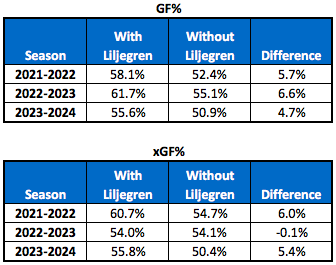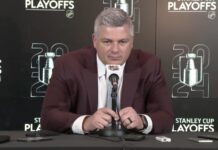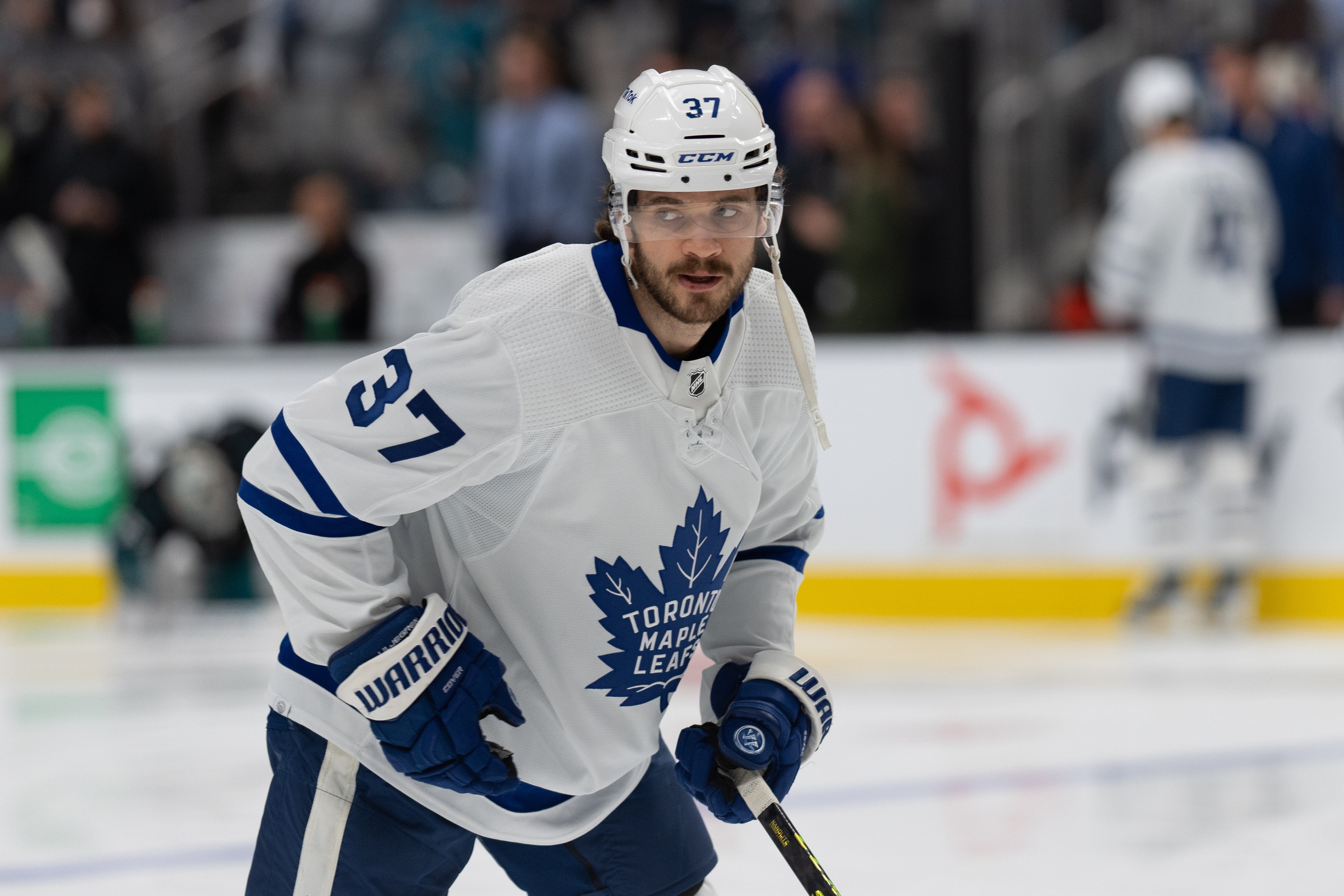The 2023-24 season is pivotal in determining Timothy Liljegren’s future in Toronto.
The 24-year-old defenseman, the team’s first-round pick back in 2017, has struggled to make it into the lineup at playoff time. Liljegren was scratched after game two of the playoffs in 2022 as Sheldon Keefe went with a trio of T.J. Brodie, Justin Holl, and Ilya Lyubushkin on the right side the rest of the way. While Liljegren did play in four playoff games against the Florida Panthers last spring, he made it into the lineup just once in round one against the Tampa Bay Lightning.
The key question the Leafs now face: Will Liljegren be a lock for Toronto’s playoff lineup for years to come? Or could he be dealt a similar fate as his good friend, Rasmus Sandin? Liljegren is now in his seventh season in the organization, and since Sheldon Keefe won a Calder Cup with him in 2018, he’s had plenty of time to evaluate the young defenseman.
Liljegren will be a restricted free agent this offseason and is eligible for arbitration. While we shouldn’t expect any sort of massive arbitration award given his minutes and point production, the Leafs are not a team that has historically spent all that much on their third pairing.
Whether it was Sandin, Mark Giordano, Travis Dermott, Zach Bogosian, Martin Marincin, Connor Carrick, or Igor Ozhiganov, no opening-night third-pairing Leafs defender has carried a $2 million cap hit. While there’s a first time for everything, with the Leafs facing a cap crunch next season, they’ll likely want to make a call on whether or not Liljegren can be a top-four defender.
If Brad Treliving sees Liljegren as a future staple in his top four, there’s likely no better time to sign him long-term than right now. However, if he sees Liljegren as a defender who could often be scratched when the games matter most, it’s probably optimal to trade him soon and maximize his value. Trading for a top-four defender with term becomes much easier if Toronto is willing to part with the young right-shooting defender.
There are some similarities to the Sandin situation from last season, where the Leafs acquired Erik Gustafsson and a first-round pick (which later became Easton Cowan). Like Liljegren, Sandin was a young defenseman with aspirations of making more than his current cap hit of $1.4 million one day.
It felt like Sandin’s payday was never going to come with Toronto, as the team already had an offensive, left-shooting defenseman in Morgan Rielly in its top four. Sandin was never going to make big money to play on the third pair, and what the Leafs needed on the left side of the top four was a bigger shutdown defender. Although Sandin and Jake McCabe weren’t dealt for one another, a first-round pick was exchanged in both cases. The Leafs essentially chose one style of defenseman over another.
Like Sandin, Liljegren will have plenty of trade value if the Leafs choose to move him. Just about every team could have interest if he’s available; he’s young enough to interest rebuilding clubs, and he’s cheap and effective enough to interest playoff teams. If you’re an opposing team, trading a top-four defender becomes a lot more palatable if Liljegren is coming back to replace those minutes.
Simply put, if the Leafs see Liljegren as a top-four defender, it’s time to challenge him with more minutes and negotiate an extension. If they do not think he’ll be able to handle a top-four role anytime soon, it’s time to trade him for someone who can.
Is Liljegren ready for an increased role?
Liljegren was on the ice for fewer five-on-five goals against per minute than any other Leafs regular last season (Note: I’m not counting players like Jake McCabe and Noel Acciari, who were only around for a quarter of the season). He’s been on the ice for a similar number of five-on-five goals against per minute this season.
Liljegren may have been a bit fortunate in 2022-23 when he was middle of the pack on the team in terms of expected goals against per minute, but he’s always been a player with strong results in terms of both goal differential and expected goal differential:
 Liljegren first earned a regular role in Toronto’s lineup in 2021-22. Since then, of the 160 defensemen who have played 2000 or more minutes at five-on-five, Liljegren ranks ninth in on-ice goals percentage (GF%) and fifth in expected goals percentage (xGF%). Toronto owns 56.9 percent of the five-on-five expected goals when he’s on the ice and an impressive 59.2 percent of the actual goals.
Liljegren first earned a regular role in Toronto’s lineup in 2021-22. Since then, of the 160 defensemen who have played 2000 or more minutes at five-on-five, Liljegren ranks ninth in on-ice goals percentage (GF%) and fifth in expected goals percentage (xGF%). Toronto owns 56.9 percent of the five-on-five expected goals when he’s on the ice and an impressive 59.2 percent of the actual goals.
The list of defenders who are over 55 percent in both metrics is small: Cale Makar, Devon Toews, Charlie McAvoy, Matt Grzelcyk, Jared Spurgeon, Jaccob Slavin, Mattias Ekholm, MacKenzie Weegar, Aaron Ekblad, Chris Tanev, Radko Gudas, and Liljegren. It’s impressive company.
The main difference between Liljegren and the vast majority of players on the above list is the quality of competition. Although he’s spent some time in the top four, he’s frequently on the third pair and rarely asked to match up against players like Connor McDavid, Nathan MacKinnon, Aleksander Barkov, or Jack Hughes. We can expect Liljegren’s numbers to drop off a bit if he takes on tougher minutes more consistently, but there’s plenty of room for his on-ice results to decline and still be quite good.
The case against Liljegren is simple: Due to the scratches in the playoffs, his head coach hasn’t exactly bought that he’s the one driving these strong on-ice results in the past. Since the start of the Matthews era, Toronto’s defenders who outperform the team’s five-on-five expected goals percentage by a wide margin tend to play in a sheltered role.
Relative Expected Goal Differential – Top 20 Seasons by Leafs Defensemen Since 2016-2017:
Source: Evolving Hockey
Perhaps the Leafs shelter their third pair more than other teams. Spending a high percentage of your minutes with Matthews would certainly help as well. Players like Jake Muzzin, T.J. Brodie, Morgan Rielly, and Jake McCabe are often asked to play against superstars who frequently dominate, resulting in their numbers taking a hit.
The Leafs were also quite dominant when Sandin was on the ice last season, and while it was a different General Manager, this didn’t stop the team from making a move at the deadline. Sandin is playing more minutes in Washington, where his team has been better when he’s not on the ice by both goal differential and expected goals percentage.
Still, it’s clear that the Leafs play well when Liljegren is on the ice. Even though it feels like he’s been around forever, he’s also still only 24. Defensemen can take forever to develop; there are many examples like MacKenzie Weegar who didn’t break out until their mid-twenties.
Liljegren is a fairly well-rounded player with no major weaknesses. He’s a fine puck mover and transition defender. At 6’1″, he’s not overly small and he’s largely able to hold his own in physical battles. This is not exactly an easy decision. Given his handedness and skillset, he’s a better fit for the Leafs than Sandin was.
The upcoming Liljegren decision
Similar to the Sandin situation, while the Leafs aren’t forced to make a trade, it’s probably optimal to make a call on what Liljegren is sooner rather than later. If the Leafs are high on him, increasing his minutes could also drive up his future cap hit. Even if you choose to go year-to-year with him due to next season’s cap crunch, Treliving can be less fussed about finding a cost-effective top-four defenseman of the future if he trusts that Liljegren will step into that type of role.
The budget for next year’s third pair is quite low due to the amount of money committed elsewhere, and if the Leafs see Liljegren as a top-four defender, they don’t have to be concerned about an arbitration award potentially pricing him out of Toronto.
If the Leafs keep him and he’s scratched in the playoffs for the third straight year, it’s going to be difficult to convince teams that he’s worth any sort of strong return. It’s easy for teams to dream about a 24-year-old right-shooting defender who can play on both special teams, but he can only be known as a “promising young player with potential” for so long. The Leafs need another top-four option right now, and if they don’t think Liljegren is going to be one, he can help them acquire someone who is.
Liljegren is too valuable as a trade asset to be a healthy scratch come playoff time. Either he should play every game or he should be traded for someone who will play every game. Toronto has plenty of depth defensemen who can play in a third-pairing role. It’s not overly expensive to acquire more.
While there are plenty of rental options that can help, the Leafs need long-term solutions in the top four. Their current top prospects are two forwards and a goaltender. Even if they hold off on making a trade for a top-four defender this season, it’s going to be hard to address the need in free agency as Toronto’s lack of cap space makes it difficult to win a bidding war.
Given how comfortable McCabe has looked on the right side, Treliving can also consider left-shooting options such as Mario Ferraro and Nick Seeler. Liljegren’s handedness may not increase his chances of sticking around as much as before, and including him in a trade might help make someone like Jamie Oleksiak available.
One way or another, we should find out what the Leafs think of Liljegren before long. If he’s a regular in the playoff lineup and they sign him to a long-term deal in the offseason, we’ll know that they’re still high on his potential and fit. If we start hearing his name in trade rumours — or if he’s a scratch come playoff time again — his days in Toronto may be numbered.




































